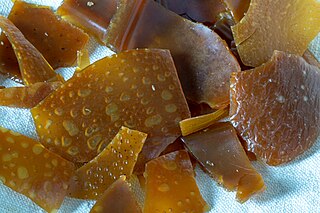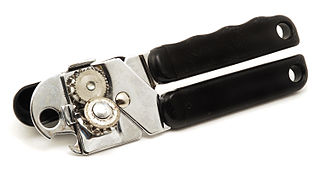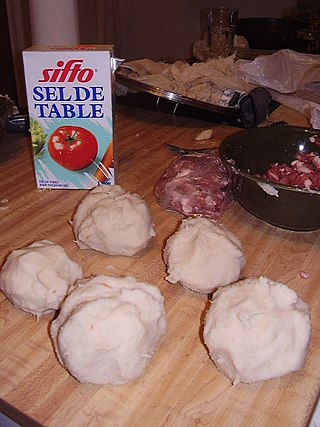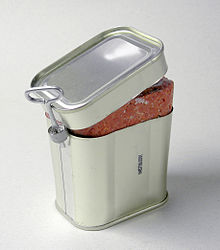
Portable soup was a kind of dehydrated food of English origin used in the 18th and 19th centuries. It was a precursor of meat extract and bouillon cubes, and of industrially dehydrated and instant food. It is also known as pocket soup or veal glue. It is essentially a partially dehydrated broth and a solid counterpart of the glace de viande used in French cuisine. It was long a staple of British seamen, military and explorers, as it would keep for many months or even a year. In this context, it was considered a filling and nutritious dish.

Corned beef, or salt beef in some Commonwealth countries, is salt-cured brisket of beef. The term comes from the treatment of the meat with large-grained rock salt, also called "corns" of salt. Sometimes, sugar and spices are added to corned beef recipes. Corned beef is featured as an ingredient in many cuisines.

The C-ration was a United States military ration consisting of prepared, canned wet foods. They were intended to be served when fresh or packaged unprepared food was unavailable, and survival rations were insufficient. It was replaced by the similar Meal, Combat, Individual (MCI) in 1958; its modern successor is the Meal, Ready-to-Eat (MRE).

A can opener or tin opener is a mechanical device used to open metal tin cans. Although preservation of food using tin cans had been practiced since at least 1772 in the Netherlands, the first can openers were not patented until 1855 in England and 1858 in the United States. These early openers were basically variations of a knife, though the 1855 design continues to be produced.

A mess kit is a collection of silverware and cookware designed for use by military personnel for food and military rations. They may also be used during camping and backpacking. There are many varieties of mess kits that militaries issue to their personnel that later become available to consumers.

United States military ration refers to the military rations provided to sustain United States Armed Forces service members, including field rations and garrison rations, and the military nutrition research conducted in relation to military food. U.S. military rations are often made for quick distribution, preparation, and eating in the field and tend to have long storage times in adverse conditions due to being thickly packaged or shelf-stable.

The K-ration was a United States military ration consisting of three separately boxed meal units: breakfast, dinner, and supper. It was originally intended as an individually packaged daily ration for issue to airborne troops, tank crews, motorcycle couriers, and other mobile forces for short durations.
Imperial Japanese rations were the field rations issued by Imperial Japan in World War II, and which reflected the culture of the Japanese military. Rations had to be stout, durable, simple, sturdy and had to survive without refrigeration for long periods of time. Typically each ration was served in the field in canned food boxes, and cooked near the battlefield. The mess tin was known as a han-gou.

The Individual Meal Pack or IMP is one type of field ration used by the Canadian Forces. The IMP is designed so that a continuous diet provides all the nutrition needed to sustain a service-person in the field. The IMP meets Canada's nutrition requirements, with the exception of calcium and folic acid, which are not significant if the consumption period of rations is less than 30 (consecutive) days. IMPs provide 1,200–1,400 calories (5.0–5.9 MJ) per meal.
The 5-in-1 ration was a United States military ration issued from 1942 to the end of World War II. As its name implies, the 5-in-1 provided the needs of five soldiers in a single ration package. Procurement ended with the war, though remaining stocks were issued to troops after the war, as well as distributed as surplus in civilian feeding programs overseas. The 5-in-1 specification remained in effect after the war, and was again used in 1948 for a new field ration.
The Mountain Ration was a United States military ration developed for use by U.S. troops operating in high-altitude or mountainous regions of the European theatre of World War II.
The Jungle Ration was a dry, lightweight United States military ration developed by the U.S. Army during World War II for soldiers on extended missions in tropical regions.

Military rations, operational rations, or military provisions are goods issued to sustain the needs of military personnel. As their name suggests, military rations have historically been, and often still are, subject to rationing, with each individual receiving specific amounts from available supplies. Military-issued goods and the rationing of such goods has existed since the beginnings of organized warfare.

The Food Packet, Long Range Patrol was a freeze-dried dehydrated United States military ration used by the Department of Defense. Developed in 1964 and intended for wide adoption during the Vietnam War, its use was eventually limited to American special operations forces during long-range reconnaissance patrols, where bulky canned Meal, Combat, Individual (MCI) rations proved too heavy for extended missions on foot. The LRP had a cold-weather warfare equivalent, the Ration, Cold Weather (RCW).

The Meal, Combat, Individual (MCI) was a United States military ration of canned and preserved food, issued from 1958 to 1980. It replaced the earlier C-ration, which it was so similar to that it was often nicknamed the "C-ration", despite the term never being used officially. The MCI was eventually replaced by the Meal, Ready-to-Eat (MRE).

Acadian cuisine comprises the traditional dishes of the Acadian people. It is primarily seen in the present-day cultural region of Acadia. Acadian cuisine has been influenced by the Deportation of the Acadians, proximity to the ocean, the Canadian winter, bad soil fertility, the cuisine of Quebec, American cuisine, and English cuisine, among other factors.

The Fray Bentos food brand is associated with tinned processed meat products, originally corned beef and later meat pies. The brand has been sold in the United Kingdom, other European countries, and Australia. Created in the second half of the 19th century, the name is derived from the port of Fray Bentos in Uruguay where the products were originally processed and packaged until the 1960s. The brand is now owned in the UK by Baxters, which manufactures the product range in Scotland. Additionally, the Campbell Soup Company manufactures and sells Fray Bentos branded steak and kidney pies in Australia.

The Benghazi burner or Benghazi cooker was an improvised petrol stove or brazier used by British Army troops and their Commonwealth and Imperial allies in the Second World War, during and after the North African Campaign.
Soup and Bouilli in England is a dish of boiled beef and root vegetables based on the traditional French dish pot-au-feu. The name comes from the general method in France of serving pot-au-feu as two courses—la soupe et le bouilli. In England as in France, bouilli referred to the boiled meat.














